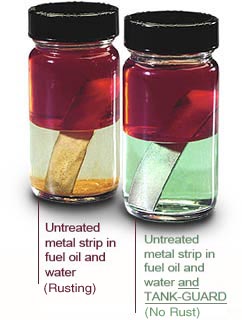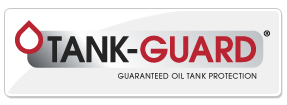Internal Tank Corrosion
WHY DO OIL TANKS FAIL?
 Internal corrosion is the leading cause of aboveground home heating oil tank failure. Water is the primary culprit. Moisture condenses inside all tanks and settles to the bottom. It combines with sediment, bacteria, and sulfur from the oil to form a crude acid.
Internal corrosion is the leading cause of aboveground home heating oil tank failure. Water is the primary culprit. Moisture condenses inside all tanks and settles to the bottom. It combines with sediment, bacteria, and sulfur from the oil to form a crude acid.
The acid on the tank bottom causes electrolysis, removing electrons from the steel tank shell. This electrolysis causes focused pitting at random sites on the tank interior within the area covered by the sludge and water. The corrosion pits are often relatively small in diameter, so tank leaks commonly occur as weeping wet spots or slow drips.
Dangers of Oil Tank Failure: Why Maintenance Matters
While oil tanks are a common choice for home heating, they come with a risk that many homeowners may not be fully aware of the danger of tank failure. Oil tank failure can lead to significant hazards for your property and the environment. In this article, we’ll delve into the potential dangers of oil tank failure and emphasize the importance of regular maintenance.
Environmental Contamination
One of the most significant dangers of oil tank failure is environmental contamination. When a tank fails, whether above ground or underground, it can release oil into the soil and groundwater. This can lead to severe ecological damage and be costly to clean up. The consequences include:
- Soil Contamination: Oil spills can saturate the soil, rendering it unsuitable for gardening or construction. It can take years and substantial resources to remediate.
- Groundwater Pollution: Oil can leach into groundwater, posing a risk to drinking water sources. Contaminated groundwater can have adverse health effects on humans and wildlife.
- Harm to Wildlife: Oil spills harm local wildlife. Birds, mammals, and aquatic creatures can suffer from exposure to oil, leading to illness or death.
Property Damage
Oil tank failure can also cause significant property damage, including:
- Structural Damage: Leaking oil can erode the foundations of buildings and structures, leading to costly repairs.
- Health Hazards: Oil spills can release harmful fumes and odors, potentially causing health problems for occupants.
- Decreased Property Value: A property with a history of oil tank failure can see a decrease in value and become challenging to sell.
Cleanup Costs
Cleaning up after an oil tank failure is an expensive and time-consuming process. Costs can include:
- Environmental Remediation: Clean contaminated soil and groundwater can cost hundreds of thousands of dollars.
- Property Repairs: Restoring property damage can be a significant financial burden.
- Legal Fees: Dealing with legal matters related to the cleanup and liabilities can further drain your resources.
Liability and Legal Consequences
Oil tank failure can lead to legal complications, including:
- Liability: As the property owner, you may be held responsible for the cleanup costs and any damage caused to neighboring properties.
- Regulatory Penalties: Failure to comply with environmental regulations can result in fines and legal action.
Health Risks
Oil spills and leaks can also pose health risks to humans, including:
- Respiratory Problems: Inhalation of oil fumes and vapors can lead to respiratory issues.
- Skin Irritation: Direct contact with oil can cause skin irritation and dermatological problems.
- Long-Term Health Effects: Prolonged exposure to oil can have long-term health consequences.
The dangers of oil tank failure extend beyond property damage; they encompass environmental, health, and legal risks. To mitigate these risks, it’s crucial to prioritize regular oil tank maintenance, inspections, and timely replacements when necessary. Engaging with certified professionals specializing in oil tank maintenance can help prevent tank failure, protect your property and the environment, and save you from legal and financial hardships. Remember, an ounce of prevention is worth a pound of cure for oil tank safety.

What’s the Best Way to Protect Oil Tanks?
You need to deal with the water on the tank bottom. Even with bottom outlet tanks, the sludge and sediment hold moisture, so water is inside every tank.
The only effective way to protect a tank against internal corrosion is to treat it with a corrosion inhibitor, like TANK-GUARD®, that mixes with the water and sludge – not with the oil. TANK-GUARD® is chemically engineered to fight the electrolysis and corrosion on the tank bottom.
Liquid TANK-GUARD® is formulated specifically for use in fuel oil tanks. It is a concentrate that is heavier than fuel oil. It goes to the bottom of the tank and reacts only with moisture and acids – not with the oil. It neutralizes acidity and protects the inside of the tank bottom against further rusting and corrosive pitting. Annual treatment with TANK-GUARD® can result in longer tank life and reduced service problems.
Remember that the oil is floating on top of the water and sludge. Additives that mix with oil can’t affect the tank bottom. Only a chemical that mixes with water can attack the real problem. It’s the best preventive medicine for oil tanks.
 If you don’t treat the water, you wait for the tank to leak.
If you don’t treat the water, you wait for the tank to leak.
Maintaining Your Heating System: Ensuring Warmth and Efficiency
While protecting your oil tank is crucial, the regular maintenance of your entire heating system is equally important. To ensure that your home stays warm and your heating system operates efficiently, consider the following essential maintenance practices:
1. Annual Professional Inspection: Schedule an annual inspection by a certified heating technician. They will thoroughly assess your heating system, checking for any issues, wear and tear, and safety concerns. This proactive approach can identify and address problems before they become costly.
2. Cleaning and Tune-Ups: Regular cleaning and tuning of your heating system can significantly improve efficiency. This includes cleaning burners, replacing filters, and checking and adjusting fuel nozzles. A well-maintained system burns fuel more efficiently, reducing energy bills and environmental impact.
3. Addressing Leaks and Drips: Pay close attention to leaks or drips around your heating system. Leaking fuel or water can damage your heating system and pose safety hazards. Promptly address and repair any leaks to prevent further damage.
4. Replace Worn Components: Over time, components of your heating system can wear out. These may include pumps, motors, or thermostats. Regular maintenance can help identify when these components need replacement, ensuring your system continues to function effectively.
5. Check for Carbon Monoxide Leaks: Heating systems, especially oil-fired ones, can produce carbon monoxide, a colorless, odorless gas that is dangerous to health. Install carbon monoxide detectors in your home and have them inspected regularly. Also, ensure your heating system is properly vented to prevent carbon monoxide buildup.
6. Insulate and Seal: Proper insulation and sealing of your home can reduce heat loss, making your heating system more efficient. Inspect doors, windows, and insulation and make any necessary improvements to keep warm air in and cold air out.
7. Upgrade When Necessary: If your heating system is outdated and inefficient, consider upgrading to a more energy-efficient model. Modern heating systems are designed to be more eco-friendly and cost-effective, ultimately saving you money in the long run.
8. Follow Manufacturer’s Recommendations: Adhere to the manufacturer’s maintenance recommendations found in your heating system’s manual. These guidelines are specific to your system and can help extend its lifespan.
In conclusion, heating maintenance is the key to a warm, comfortable home and an efficient heating system. Regular inspections, cleaning, and proactive repairs can prevent costly breakdowns and ensure your heating system operates at its best. By taking these steps, you enhance your comfort and contribute to a more sustainable and energy-efficient home. Don’t underestimate the importance of heating maintenance—it’s an investment in your comfort and peace of mind.
Hillside Insurance Plans
Replacement Parts, Inspections, Tune-Ups, Adjustments, and more. See what plan is right for your needs.
Hillside Account Application
Establish an account by filling out this application. It’s that easy!
Budget Sign-up Form
Hillside’s budget plan stretches annual expenses into monthly payments. We use a simple formula…your annual expense with Hillside divided into the number of months remaining in our budget season. Plans designed specifically for your budget.
Why You Can Trust Hillside
★ ★ ★ ★ ★
“After a power surge and a power outage I found out it had ruined my heater. Since both my heater and AC were close to 20 years old I contacted Hillside to replace both. I have to say I was extremely satisfied and pleased with their service. It was all done expertly and I would highly recommend them to anyone. Thank you Hillside!”
– DOROTHY
Verified Facebook Reviews
The Hillside Maintenance Plans
Keeping Your Paws Comfy All Year Round
The Hillside Maintenance Plans are designed to prevent minor problems from turning into major issues! Extend the life of your equipment, reduce the need for costly repairs, and increase the performance of your heating and cooling systems while lowering your utility bills.



